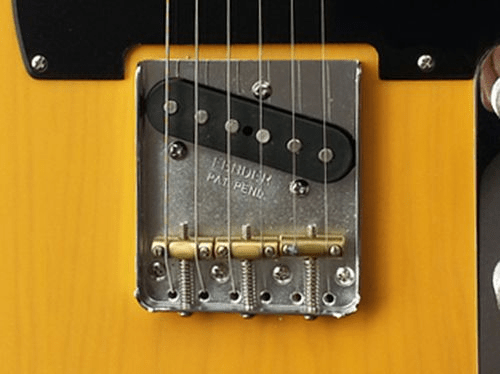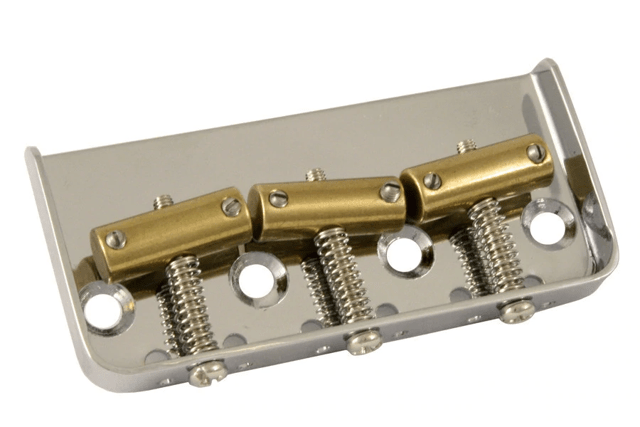Telecaster Bridges
 A vintage-style Telecaster
bridge.
A vintage-style Telecaster
bridge.
A Tele bridge is perhaps the clearest example of Leo Fender’s burning hatred of spending money. It’s literally a bunch of screws, a piece of sheet metal bent into shape, and a brass rod cut into three sections. I’d be surprised if these cost more than a dollar to manufacture.
When shopping for an upgrade, make sure to double-check the dimensions and number and placement of mounting screws. There are a number of variants of Tele bridges, and although the four-screw mount (pictured at the top) is the most common, there are also three-screw bridges that have the screws in different locations. Some bridges will also only allow you to string the guitar through the body, while some will offer the option to load in the strings from the back of the bridge.
Tele bridges have… a number of problems and quirks. The most obvious and painful one is the fact that, because there are two strings per saddle and so you cannot adjust the intonation of each string individually, it is physically impossible to get a vintage-style telecaster bridge to intonate correctly.
Older vintage bridges may also not have string grooves at all, and rely only on friction for the string to stay in place and not move side-to-side. These are prone to the “sitar effect”, horrendous buzzing, and messy string spacing.
Upgrade Options
Over the years, both Fender and third parties have attempted a number of remedies to these problems. First came the “hammer-saddle” bridge:
 A
“hammer-saddle”-style Tele bridge.
A
“hammer-saddle”-style Tele bridge.
These are, somehow, even worse than the old design. They break strings quite often — because the strings end up rubbing against the sharp threads of the height adjustment screws — the saddles are very rattly and can even end up flipping (because the string applies heavy pressure to only one side of the saddle), and they either don’t have string grooves at all, or the string grooves are not deep enough to get rid of the “sitar” effect. My recommendation — stay away from these. If you have one of those, it’s a prime candidate for an upgrade.
Later came the “modern” six-saddle bridge, with saddles resembling those on a Stratocaster. There’s not much I can say about these; it’s an okay design, on par with most other guitar bridges. I, personally, think it can look slightly out of place on a Tele, but it does the job pretty well. There’s lots of aftermarket variants of this design.
Fox’s Gear: Compensated Saddles
There is a middle ground that lets you keep your beefy telecaster saddles with two strings holding each of them down and vintage look, and fixes the “sitar effect” while letting you achieve perfect intonation: compensated saddles.
> ABM compensated Telecaster bridge saddles.
These are a drop-in replacement for vintage saddles that have string grooves cut into them at precise depths that allow each pair of strings to intonate correctly.
Full disclosure, I didn’t trust them until I ordered and installed a set of Gotoh compensated saddles in my Tele on a whim and was shocked to discover that it intonates perfectly with them on. If you have a vintage-style bridge and want to keep the vintage vibe, I highly recommend trying them out.
They’re available in a variety of styles, colors, and materials — even including titanium — from loads of different manufacturers. Fender even makes a set of compensated saddles that have the intonation individually adjustable with a screw, but I’m told they break very easily, so I would suggest staying away from those ones.
Quirks
The vintage-style saddles, compensated or not, have another quirk that makes setup slightly different from setting up other kinds of saddles or bridges — because of how bulky they are and how high they sit above the bridge, intonation and action adjustments are not truly independent with these saddles. Raising the action simultaneously extends the scale length, and extending the scale length (tightening the screw that sets intonation) simultaneously raises the action. Setting up a vintage Telecaster bridge is a bit of a balancing act, but on the other hand it’s not more time-consuming than other bridges because you only have three — rather than six — saddles to adjust.
If you happen to have a Tele where the saddles sit particularly low for correct action or particularly far back for correct intonation, you may find that either the long intonation screws or the small saddle height screws dig painfully into your palm when palm muting. In that case, just grab a dremel and shave off a bit off the ends of the screws; don’t worry too much about messing it up, the screws are dirt cheap.
If you’re planning on pickup swaps or alterations, there are also “cut off” or “short” Tele bridges made to accommodate a bridge humbucker. However, if you keep a single coil in the bridge position with a “short” bridge, you will have to alter the mounting and drill new holes, as the bridge pickup on a Tele normally mounts to the bridge.
 A “short” Tele bridge.
A “short” Tele bridge.